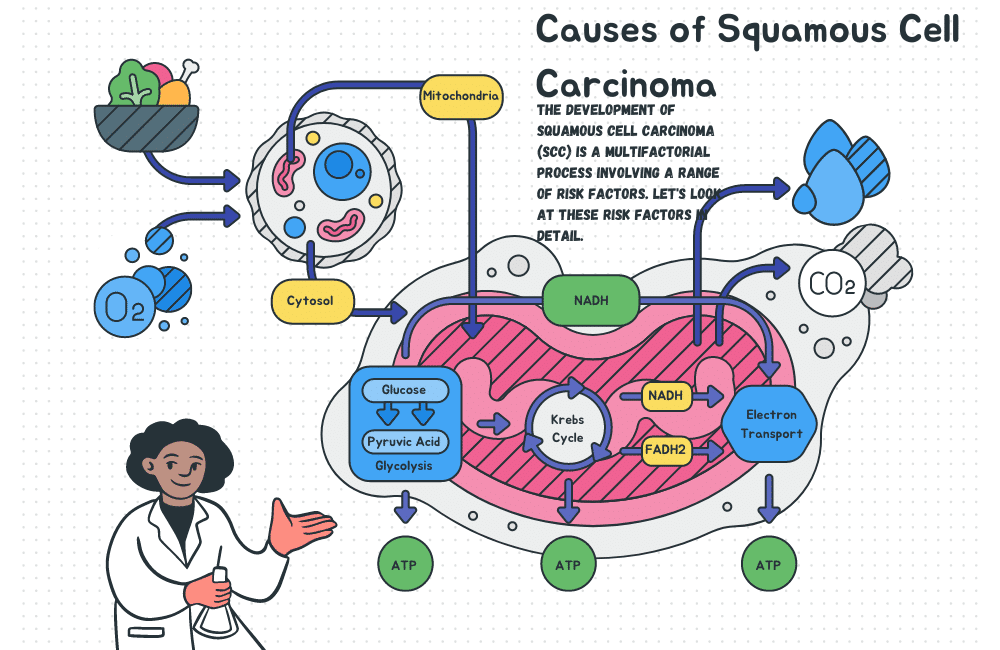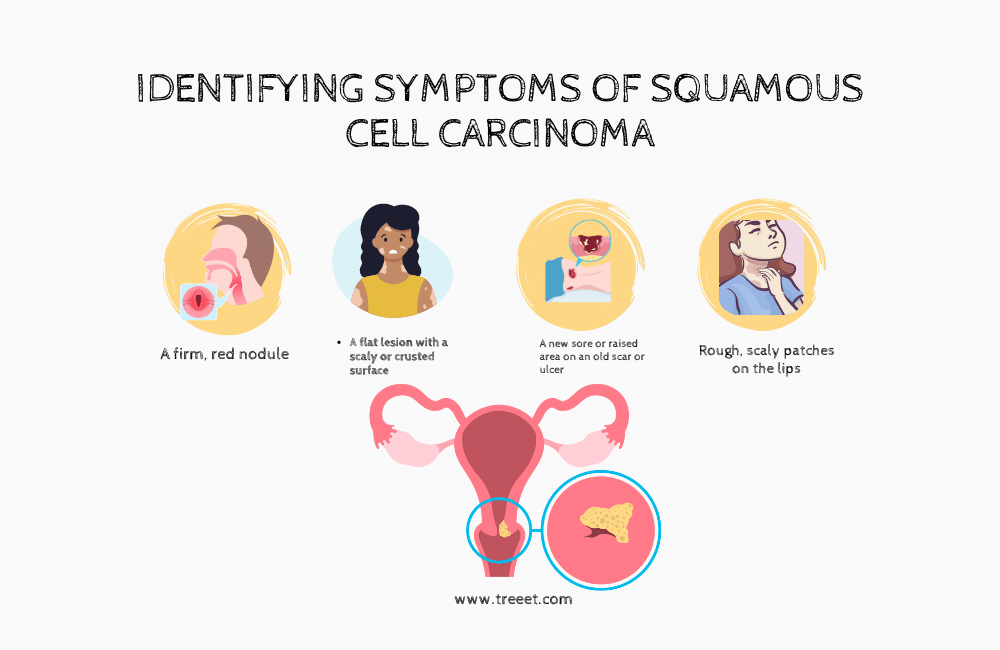Squamous cell carcinoma (SCC) is a common type of skin cancer known for its potential to spread to other body parts if left untreated. This article delves into the nature of SCC, its causes, symptoms, diagnosis, and treatment options. Understanding these factors can promote early detection and more successful treatments.

What is Squamous Cell Carcinoma (SCC)?
Squamous cell carcinoma, often abbreviated as SCC, is a skin cancer that originates from squamous cells. These cells form the outermost layer of skin, the epidermis, and are also found in various body tissues like the respiratory and digestive tracts. When identified and treated early, SCC typically carries a high success rate.
Causes of Squamous Cell Carcinoma
The development of squamous cell carcinoma (SCC) is a multifactorial process involving a range of risk factors. Let’s look at these risk factors in detail.

Ultraviolet (UV) Radiation
Sunlight and artificial tanning sources emit UV radiation that can cause damage to the DNA in skin cells, leading to uncontrolled cell growth and, eventually, cancer. UV radiation is classified into two types – UVA and UVB. Both can damage the skin, but UVB is particularly harmful because it has more energy and can directly damage the DNA in skin cells. While SCC can also occur on parts of the skin not typically exposed to sunlight, most cases are associated with areas that frequently receive UV radiation.
Advanced Age
With increasing age, cumulative exposure to sunlight increases, enhancing the risk of DNA damage in skin cells. Furthermore, the skin’s ability to repair DNA damage diminishes with age, leading to a higher likelihood of mutations. These mutations can accumulate over time and lead to uncontrolled cell growth, forming SCC.
Light Skin, Hair, and Eyes: A Higher Risk for SCC
Melanin, the pigment responsible for the color of our skin, hair, and eyes, serves a crucial function beyond aesthetics – it helps protect our skin from the harmful effects of ultraviolet (UV) radiation. This pigment absorbs UV radiation and disperses it as heat, reducing the risk of DNA damage that can lead to skin cancer. Therefore, the amount of melanin in your skin can significantly influence your risk of developing squamous cell carcinoma (SCC).
Light Skin: Individuals with lighter skin tones have less melanin and less natural protection against UV radiation. Consequently, they are more susceptible to sunburns and skin damage, which can accelerate skin cell mutations leading to cancer. This is why people with light skin have a higher incidence of SCC than those with darker skin tones.
Light Hair: People with light-colored or red hair often have skin types more susceptible to sun damage. Light hair color can indicate a genetic makeup that is less capable of repairing the DNA damage caused by sun exposure, thereby increasing the risk of SCC.
Light Eyes: Similarly, individuals with light-colored eyes (blue, green, or gray) generally have less melanin in their skin. Thus, they may be at a higher risk of developing SCC, particularly around the eye area, due to the reduced protective effect of melanin.
Identifying Symptoms of Squamous Cell Carcinoma
The primary symptom of SCC is persistent, often irregular, skin growth. Other signs include:

- A firm, red nodule
- A flat lesion with a scaly or crusted surface
- A new sore or raised area on an old scar or ulcer
- Rough, scaly patches on the lips
These symptoms may vary depending on the specific body part affected. Any persistent change in the skin’s appearance should warrant medical attention.
Diagnosis of Squamous Cell Carcinoma
Diagnosing squamous cell carcinoma (SCC) involves a few steps to ensure accuracy. These steps are outlined in detail below.
Physical Examination: A thorough physical examination is the initial step in diagnosing SCC. This involves visually inspecting the suspicious skin lesion and assessing its size, shape, color, and texture. The doctor will also consider the patient’s medical history, including exposure to risk factors such as UV radiation and certain chemicals. This examination typically happens during a regular check-up or if a patient has noticed a suspicious skin change and sought medical attention.
Biopsy: If the doctor suspects that a lesion could be SCC based on the physical examination, the next step is a biopsy. Depending on size and location, the doctor removes a small piece of skin or entire growth during a biopsy. This procedure is usually done under local anesthesia, which numbs the area so the patient doesn’t feel pain. The collected sample is then sent to a laboratory.
Histopathological Examination: In the lab, the sample is examined under a microscope by a pathologist, a doctor specializing in diagnosing diseases by studying cells and tissues. The pathologist looks for specific changes in the cells that indicate SCC. The biopsy result will confirm whether SCC is present and may also provide information about the subtype of SCC, which can influence treatment decisions.
Staging: If the biopsy confirms the presence of SCC, the next step is staging, which determines the extent of the cancer. Staging helps to guide treatment decisions and provide a prognosis. Staging may involve imaging tests like CT scans, MRI, or PET scans, and in some cases, additional biopsies of lymph nodes or other areas might be needed.
Staging for SCC is based on the tumor’s size and location, whether it has spread to the lymph nodes, and whether it has metastasized (spread) to other body parts. The stages are typically numbered from 0 to 4, with stage 0 indicating carcinoma in situ (cancer cells are present but have not spread) and stage 4 indicating the cancer has spread to distant body parts.
Treatment Options for Squamous Cell Carcinoma
Treatment for SCC depends on the cancer’s size, location, depth, and the patient’s overall health.
- Surgical Methods: These can include simple excision (removing the tumor and some surrounding tissue), Mohs surgery (removing the cancer layer by layer), or cryosurgery (freezing the cancer cells).
- Radiation Therapy: High-energy beams are used to kill cancer cells, typically used when surgery isn’t an option.
- Topical Treatments: These are medicines applied directly to the skin for early-stage SCC.
- Systemic Therapy includes chemotherapy or targeted therapy, generally reserved for advanced SCC.
Prevention: Reducing Your Risk of SCC in Detail
Preventing squamous cell carcinoma (SCC) primarily revolves around reducing exposure to risk factors, particularly ultraviolet (UV) radiation, and conducting regular skin examinations. Here’s a detailed look at preventive measures you can take:
Limit Sun Exposure
The sun is the main source of UV radiation, a primary risk factor for SCC. Limiting your time in the sun, especially during peak UV hours (usually between 10 a.m. and 4 p.m.), can significantly reduce your risk. Seeking shade under trees, umbrellas, or other shelters can help protect you from direct sunlight.
Avoid Tanning Beds
Tanning beds and sunlamps also emit UV radiation. Studies have linked using tanning beds to an increased risk of SCC. Avoiding artificial tanning can thus help prevent SCC.
Use Sunscreen
Sunscreen acts as a protective shield against harmful UV rays. Choose a broad-spectrum sunscreen that blocks UVA and UVB rays with an SPF of at least 30. Apply it liberally on all exposed skin areas, even on cloudy or cold days, as UV rays can penetrate clouds. Reapply it every two hours and immediately after swimming or sweating excessively.
Wear Protective Clothing
Clothes can physically block UV radiation. Long-sleeved shirts, long pants, and wide-brimmed hats can provide good protection. Some clothing even comes with an Ultraviolet Protection Factor (UPF) rating, which indicates how much UV radiation the fabric can block.
Regular Skin Examinations
Regular skin self-exams can help you detect changes or new growths that might indicate SCC. This involves regularly checking your skin for new growths, sores that don’t heal, or existing growths that begin to change or bleed. Dermatologists also can perform comprehensive skin exams during routine check-ups.
Avoid Exposure to Certain Chemicals
If you work in industries that expose you to carcinogens like arsenic and coal tar, use protective clothing and safety protocols to minimize contact with these substances.
Quit Smoking
Smoking tobacco has been linked to an increased risk of SCC, particularly oral SCC. Quitting smoking can significantly reduce this risk.
Maintain a Healthy Immune System
Some conditions and medications can weaken the immune system, increasing the risk of SCC. If you have a weakened immune system, work with your healthcare provider to manage your condition and reduce your SCC risk.
Summing Up
While potentially serious, early detection and treatment can effectively manage squamous cell carcinoma. Understanding its nature, causes, symptoms, and treatments empowers individuals to take proactive steps in their skin health. While exposure to the sun is a daily part of life, managing that exposure and recognizing early signs of SCC can make a significant difference.
Note: This article is informational and should not replace professional medical advice. If you're experiencing symptoms consistent with SCC, contact a healthcare provider promptly.

